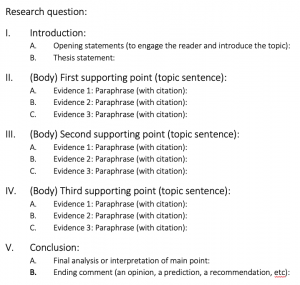Unit 4: Fundamentals of Academic Essay Writing
26 Writing a Detailed Outline
Preview Questions:
- How is a detailed outline different from a rough outline?
- What information should be included in a detailed outline?
- Why are detailed outlines important? How can they help you as a writer?
- What are some possible formats of detailed outlines? Which format do you typically use?
Use your rough outline and evidence to create a detailed outline which will be a guide for constructing your first draft.
A detailed outline includes:
- (a research question)
- a thesis statement
- topic sentences to express each supporting point
- evidence for each supporting point
- citations to indicate where each piece of evidence is from
The detailed outline is a tool for organizing ideas, but it can be modified during the writing process (e.g. you might change the order of ideas or add or delete information). The traditional alphanumeric outline below is one of the most common in academic writing. It is easy to construct using the outline features in MS Word.
Example 1: An alphanumeric outline

Additional examples
It does not matter whether you use numbers, letters, bullets, or other symbols; what is important is that you use a reasonable, clear visual method to represent your overall organization and hierarchy of main ideas and supporting ideas.
Here are additional examples, which accomplish the same goal as the outline above:
Example 2
Research question:
- Introduction:
- Opening statements (to engage the reader and introduce the topic):
- Thesis statement:
- (Body) First supporting point (topic sentence):
- Evidence 1: Paraphrase (with citation):
- Evidence 2: Paraphrase (with citation):
- Evidence 3: Paraphrase (with citation):
- (Body) Second supporting point (topic sentence):
- Evidence 1: Paraphrase (with citation):
- Evidence 2: Paraphrase (with citation):
- Evidence 3: Paraphrase (with citation):
- (Body) Third supporting point (topic sentence):
- Evidence 1: Paraphrase (with citation):
- Evidence 2: Paraphrase (with citation):
- Evidence 3: Paraphrase (with citation):
- Conclusion:
- Final analysis or interpretation of main point:
- Ending comment (an opinion, a prediction, a recommendation, etc):
Example 3
Research question:
- Introduction:
- Opening statements (to engage the reader and introduce the topic):
- Thesis statement:
- (Body) First supporting point (topic sentence):
- Evidence 1: Paraphrase (with citation):
- Evidence 2: Paraphrase (with citation):
- Evidence 3: Paraphrase (with citation):
- (Body) Second supporting point (topic sentence):
- Evidence 1: Paraphrase (with citation):
- Evidence 2: Paraphrase (with citation):
- Evidence 3: Paraphrase (with citation):
- (Body) Third supporting point (topic sentence):
- Evidence 1: Paraphrase (with citation):
- Evidence 2: Paraphrase (with citation):
- Evidence 3: Paraphrase (with citation):
- Conclusion:
- Final analysis or interpretation of main point:
- Ending comment (an opinion, a prediction, a recommendation, etc):

